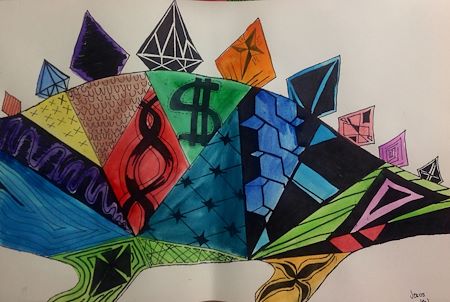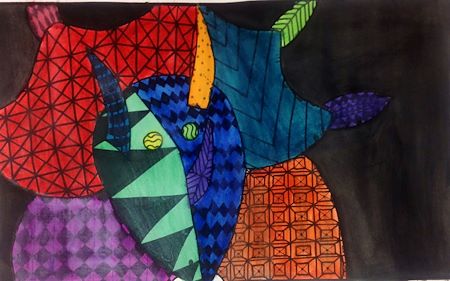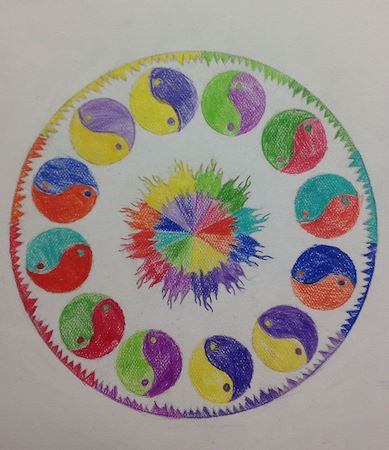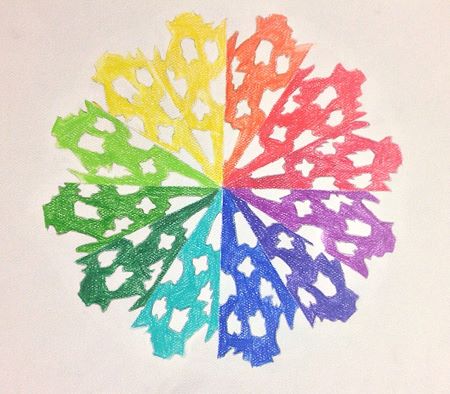Tuesday, December 10, 2013
Marilyn meet Super Kylie
In the busyness of life, I forget to post things to this blog! Really if you want to stay connected to my world, you need to follow my personal blog at www.faithhopeandart.blogspot.com
Wednesday, October 23, 2013
Getting ready for CLAY!!! Tested Tips for Teachers!
I've come to realize that some of the things that come naturally to me as an art teacher are not necessarily things that other art teachers are good at. So, I'm going to start sharing a few tips. (Then I won't feel so bad when I steal art technique tips from other teachers!)
So today I'm going to share how I get ready to start clay for the first time in Art 1.
First, get out the OLDEST bags of clay first. I am using Low Fire White clay. I have 3 bags that I need to stretch out between 3 Art 1 classes. Two bags are pretty hard. One bag is nice and soft. I will force the students to use the two hard slabs first. How you say.. easy. :)
Take the heavy block of clay out of the bag. (Yes I am working on the floor. It's easier for me to work on the floor and I've come to realize that it doesn't really matter if the clay is absolutely "clean" when I give it to students, it's not going to be "clean" when they are finished. It WILL have random bits of junk/hair/trash in it no matter what I say or do.)
Here is my block of clay. I do at least set it on it's plastic bag.
Now take your wire cutter and cut the block in half.
Lay 1/2 down and stand the other 1/2 on the clay base. Cut it in 1/2 as well.
Notice the supplies on my front small table. I have EXACTLY the number of sharp instruments that we need for the tables. I only allow ONE of each tool per table. Students just have to share. I can keep up with seven of each of the tools, but I can't keep up with 25 of each!
You might also notice the canvas boards that I have in the tub next to the clay. These canvas boards are GREAT! They don't totally protect my tables, but they do a pretty good job. A lot of people cover the entire table for clay, but I don't have time as I teach Art 1, Art 2 and then back to Art 1. My advanced kids don't do clay at the same time as Art 1 and they really, really don't appreciate getting clay dust on their drawings!
So there you have it.
Art 1 is making 3 clay coils and a pinch pot today!
So today I'm going to share how I get ready to start clay for the first time in Art 1.
First, get out the OLDEST bags of clay first. I am using Low Fire White clay. I have 3 bags that I need to stretch out between 3 Art 1 classes. Two bags are pretty hard. One bag is nice and soft. I will force the students to use the two hard slabs first. How you say.. easy. :)
Take the heavy block of clay out of the bag. (Yes I am working on the floor. It's easier for me to work on the floor and I've come to realize that it doesn't really matter if the clay is absolutely "clean" when I give it to students, it's not going to be "clean" when they are finished. It WILL have random bits of junk/hair/trash in it no matter what I say or do.)
Here is my block of clay. I do at least set it on it's plastic bag.
Now take your wire cutter and cut the block in half.
Lay 1/2 down and stand the other 1/2 on the clay base. Cut it in 1/2 as well.
Like this.
Now take the 1/4 wedge and cut it into 4 or so parts. Try to be somewhat consistent in size. But be ready to say.. "You get what you get and you don't throw a fit." Yes, even in high school!
Now take EACH wedge and place it into a plastic bag that zips closed. Brand doesn't matter. I use LOTS of ziploc bags. I make the quart size bags a supply item that kids have to provide. DON'T CLOSE THE BAG YET!!!
6. Now take the bags over to the sink and if the clay is already leather hard, place a few drops of water in each bag and close up the bag.
7. Place the OLDEST clay at the BOTTOM of the bucket. Place the BEST clay somewhere else until the old clay is used. (Notice the best clay is sitting on my counter inside gallon storage bags.. I'll pull these out at the end of the day for my last class. This is two-fold.. it forces the students to use the old clay first and it makes sure that every once in a while the last class of the day gets the best supply!)
Side note here... the students ALWAYS dig to the bottom of the bucket thinking that they are going to get the best of something...
Prepare your supplies for your table stations I use the lids that come with small storage tubs for "plates" for my tables. I have one set on my front counter as an example of how I expect the students to place their supplies.
Notice the supplies on my front small table. I have EXACTLY the number of sharp instruments that we need for the tables. I only allow ONE of each tool per table. Students just have to share. I can keep up with seven of each of the tools, but I can't keep up with 25 of each!
You might also notice the canvas boards that I have in the tub next to the clay. These canvas boards are GREAT! They don't totally protect my tables, but they do a pretty good job. A lot of people cover the entire table for clay, but I don't have time as I teach Art 1, Art 2 and then back to Art 1. My advanced kids don't do clay at the same time as Art 1 and they really, really don't appreciate getting clay dust on their drawings!
So there you have it.
Art 1 is making 3 clay coils and a pinch pot today!
Friday, October 18, 2013
The Healing Tree
Three of my advanced art students have been volunteering their time and talent for the local hospital's wound care clinic by painting a "healing tree".
It's been a slower process than I thought it would be because they can only work from 4pm to 6pm during the week.
But the end result is going to be fantastic!
Here are a few pictures of the students at work.
I am proud of these girls and their work ethic! I met the doctor that works out of the clinic a couple of days ago and he asked me if I had been working on the mural with the girls. I said nope. And the nurses quickly said it's just been the girls, that I haven't picked up a paint brush. I told him that if I have done my job, I can tell the students the expectations, give them feedback and a little guidance and make sure that they have the necessary supplies, but I shouldn't have to do the project for them. He seemed a little surprised that I would be willing to give the students so much responsibility, I just said these are good kids and smiled. It was really interesting, he was so complimentary of the work, he just couldn't believe that I didn't force my hand in the work. I guess that the difference in our professions.
Thursday, October 10, 2013
Animal Contour with Tangled Lines Watercolor Painting
For the second project in Art 1, students were asked to create a contour drawing of an animal. Becuase I wanted to reinforce the idea that they would be drawing from OBSERVATION, I had them draw various stuffed animals that I purchased from the dollar store!
While the animals drawings were not as inspired as they might have been if I had allowed them to draw from photographs, one of the most important things that students must learn in Art 1 is that they MUST draw from observation!
Anyway... we did a series of contour drawings of stuffed animals. I had bears, monkeys, a couple birds and various other stuffed animals. After a couple of days drawing, the students were asked to draw their favorite drawing on larger piece of paper, making sure that their animal was larger than the paper so that it "hung off" the paper on 3 sides.
Then the students created line drawings inside each section of the animal. If the student didn't listen at the begining and only had one big section of stomach, he/she found out really quickly that their project was going to be boring! After the line drawings (in sharpie) were finished, the students painted each section a different color using watercolors.
Here are some of the fun finished pieces. Click Here to see the entire gallery.
For more instructions see my snapguide below.
Check out How to Draw an Animal Inspired Abstract Drawing by Emily McLemore on Snapguide.
Finished Radial Design Color Wheels
A few weeks ago Art 1 students completed their Radial Design Color Wheels.
Or you can just look at a couple of highlights below.
The project was a hit and one that I think that I will do every year as a first project. I learned so much about the students and could really see the strengths and weakness of each student immediately!
For the complete lesson, watch the snap guide tutorial.
Check out How to Create a Radial Design Color Wheel by Emily McLemore on Snapguide.Sunday, September 8, 2013
Art 1 Color Project
Now that students have learned about the color wheel, they will begin creating a radial design color wheel in class. If you want to read more about the process, click here.
Here is a teacher sample that I created this afternoon.
Need instructions? See my snapguide!
Wednesday, July 17, 2013
Art Supply Lists for Fall 2013
I wish I knew how to upload a pdf file so that you could download and save this. I don't. Sorry. So you will just have to print this page or copy and paste the portion you need!!
Now you can purchase supplies anywhere you want.. but I do know that the absolute EASIEST way to purchase supplies is to go to The Apple Tree or call Regina at 254-968-4440 and purchase all the supplies in one "kit" at a discounted price. (I think it's 10% off... not sure)
Art 1 Supply List
Now you can purchase supplies anywhere you want.. but I do know that the absolute EASIEST way to purchase supplies is to go to The Apple Tree or call Regina at 254-968-4440 and purchase all the supplies in one "kit" at a discounted price. (I think it's 10% off... not sure)
Art 1 Supply List
- 16 Color Watercolor Set
- Sketchbook
- 24 ct Colored Pencils
- Pencil Set
- Drawing Tools
- Scissors
- Glue
Art 2 Supply List
- 24 ct Colored Pencils.. Prismacolor Preferred
- 18 piece Watercolor set
- Paint Palette with Cover
- Sketching Set
- Sketch and Wash Pencil
- Strathmore Drawing Tablet: 70lb 50 sheets
- Optional: 16 ct Oil Pastel
- Basic art supplies from Art 1
Art 3 and AP Supply List
- Royal and Langnickel Palette Paper
- Liquitex Basics Acrylic Set 6 colors
- Liquitex Basics White Nylon Brush set 6 brushes
- Micron Pen Set 01 Nib 6 colors
- Basic art supplies from Art 1 and 2
Monday, June 17, 2013
T Shirt Tapestry
Tshirt Tapestries have become great "filler" activities in my classroom. I have tubs of cut up tshirts and precut rectangles of the hook and loop canvas. When students are finished with whatever the current project is and I'm not ready for the group to move to the next project, students have the opportunity to work on a tshirt tapestry. I call them tapestries because they aren't rugs and they aren't paintings and they aren't sculptures, so tapestry it is!
How do you make your own tshirt tapestry?
1. start with a lot of tshirts and cut them into strips. I cut the entire shirt into 1/2 inch wide strips. I don't use the sewn selvages or the collar, but I use the rest of the shirt. I then cut the strip into about 4 or 5 inch long pieces. How long do you cut them? It depends on how shaggy you want your tapestry!
2. Decide on if you want to create a pattern or image. Then get to work!
3. Take a strip and gently pull it so that it rolls in on itself a little bit. Then fold in in half, run it under into a square, pull it through the other side and slip it through loop you just made and pull tight. Okay, that makes very little sense.. google latch hook rugs and follow the steps... I don't use a latch hook as I find it a lot more work.
4. Beware, this is pretty mindless work, but it is NOT fast!
Here is one about finished. It is very shaggy!
I love this one! Too bad the blue section is backwards... And they ran out of red shirts.
So close! They just needed a dozen more red strips. Sorry guys!
And don't you love the back of this! The art 1 guys who worked on this created it as they went. I love their problem solving and concept. Yes, the flag is backwards and they ran out of red, but the overall job is really nice. I will be using this in the future as a sample of great technique and good design, but lack of execution in the flipping of the design and running out of supplies.
This final tapestry is way, way to shaggy and the canvas showing through tells me that they didn't work consistently on their lines. You can skip a row, as long as you embed the skipped squares between solid rows of tshirt. This one is not consistent.
So, if you are looking to get rid of old tshirts, this is a great project for that! And, it is also a really nice differentiation project. The project below, while I started it with my daughter at home, I took it to school and had a couple of art 1 students work along a life-skills student. He threaded the strips through the hook base and the other students completed the loop. The students did a great job working together and the non-verbal life skills student was able to complete an on-level art 1 project with his regular ed peers!
Sunday, June 16, 2013
From 1/2 the face to the full face.
For my fall final exam, art 1 students completed the other half of the face drawing. For my spring final exam in art 1, students had to draw the entire face. They could reference the picture from the fall, but they had to draw from observation as well. I love the progression!
Below are just a few examples, but these are not the only ones that were awesome. I was so pleased with the results of the project and love how you can see the individual students artistic development!
I would love to give credit to the individual studetns here, but I'm not since the faces are here. If you know these students, give them a shout in person!
And let me remind you again... these are ART 1 students!!
Embroidery Hoop Printmaking Tutorial
Embroidery Hoop Printmaking Tutorial
Are you interested in printmaking but not sure where to start? Well, embroidery hoop printmaking isn't the easiest way to start printmaking, but it is super cheap! So how do you start?
Well, start with a simple image. NOT LIKE MINE! Sorry, you have to make do with my image as this was an actual project.
1. Print your image on copy paper.
2. Get an embroidery hoop and some sheer fabric. I bought a fabric panel at the discount store. Cut your fabric a little larger than your hoop and pull it super tight.
3. Set your hoop with fabric down FLAT on to your design. It is important that you will see the image CORRECTLY with the hoop facing you. (see below).
4. Take your sharpie and draw you image onto the fabric. Yes, the sharpie will bleed, but where you actually draw will be black and the bleed will be gray.
5. Flip over the design and check to see how it looks.
8. For tiny areas, you toothpicks.
10. Let the frame completely dry and then paint another coat. If you can see through the fabric, it is not sealed enough.
11. Try out your frame on a piece of paper or throw away piece of fabric using acrylic paint. I like to pull the image with a credit card. It is important the frame is flat on your fabric and that you pull the print at a 45 degree angle. Only pull across each part of the image ONE time and only from ONE direction!. If it's not a great print, wash your frame out, let it dry and add mod podge to the "bad" spots.
12. And here is what it looks like printed.
Words of caution...
This printmaking process is not for the faint of heart nor is it good for long runs. However, it would be ideal for a classroom project where every student was allowed to create their own prints. I would say that you could probably get about 10 good prints, maybe more, but the screen seems to break down and allow bleedouts quickly. Pulling from different angles makes bleedouts happen faster.
I would suggest that you NOT use words, or if you do, no smaller than the "spaced out" words that I have on my image.
Good luck!
Subscribe to:
Posts (Atom)


















































